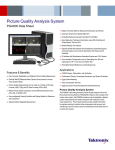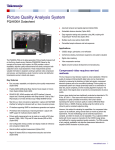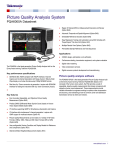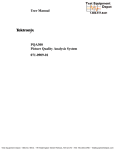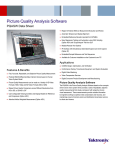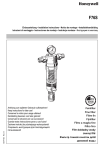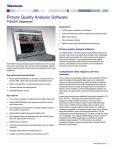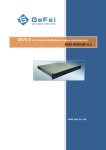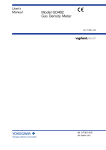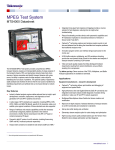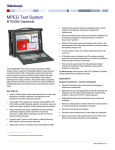Download Picture Quality Analysis System
Transcript
Picture Quality Analysis System PQA500 Features & Benefits Fast, accurate, repeatable and objective picture quality measurement Predicts DMOS (differential mean opinion score) measurement based on human vision system model Picture quality measurements can be made on a variety of HD video formats (1080i, 720p) and SD video formats (525 or 625) Makes picture quality comparison across different resolutions from HD to SD or HD/SD to CIF User-configurable viewing condition and display models for reference and comparison Attention/artifact weighted measurement Picture Quality Analysis System The PQA500 is the latest-generation Picture Quality Analyzer built on Tektronix’ Emmy Award-winning PQA200/300. Based on the concepts of the human vision system, the PQA500 provides a suite of repeatable, objective quality measurements that closely correspond with subjective human visual assessment. These measurements provide valuable information to engineers working to optimize video compression and recovery and maintaining a level of common carrier and distribution transmission service to clients and viewers. Compressed Video Requires New Test Methods The true measure of any television system is viewer satisfaction. While the quality of analog and full-bandwidth digital video can be characterized indirectly by measuring the distortions of static test signals, compressed television systems pose a far more difficult challenge. Picture Quality in a compressed system can change dynamically based on a combination of data rate, picture complexity and the encoding algorithm employed. The static nature of test signals does not provide true characterization of picture quality. A test scene with natural content and motion can be used, with human viewers reporting the results, but this method of evaluating the capa- bilities of a compressed video system is inefficient and not very objective. Subjective testing with human viewers is impractical for CODEC design and operational quality evaluation. The PQA500 provides a fast, practical, repeatable and objective measurement alternative to subjective evaluation of picture quality. Human viewer testing has been traditionally conducted as described in ITUR Rec. BT.500-11. A test scene with natural content and motion is displayed in a tightly controlled environment, with human viewers expressing their opinion of picture quality to create a Differential Mean Opinion Score or DMOS. Extensive testing using this method can be refined to yield a consistent subjective rating. However, this method of evaluating the capabilities of a compressed video system can be inefficient, taking several weeks to months to perform the experiments. This test methodology can be extremely expensive to complete and often the results are not repeatable. Thus, subjective DMOS testing with human viewers is impractical for the CODEC design phase and inefficient for ongoing operational quality evaluation. The PQA500 provides a fast, practical, repeatable and objective measurement alternative to the subjective DMOS evaluation of picture quality. Automatic temporal and spatial alignment Easy regression testing and automation with XML scripting Multiple results view options Optional SD/HD SDI interface for generating/capturing video Pre-installed sample reference and test sequences Applications CODEC design, optimization and verification Conformance testing, transmission equipment and system evaluation Digital video mastering Video compression services Digital consumer product development and manufacturing Picture Quality Analysis System PQA500 How It Works UI Top Image of PQA500. System Evaluation The PQA500 can be used for installation, verification and trouble-shooting of each block of the video system because it is video technology agnostic: any visible differences between video input and output from processing components in the system chain can be quantified and assessed for video quality degradation. Not only can CODEC technologies be assessed in a system, but any process that has potential for visible differences can also be assessed. For example, digital transmission errors, format conversion (i.e., 1080i to 480p in set-top-box conversions), 3-2 pull-down, analog transmission degradation, data errors, slow display response times, frame rate reduction (for mobile transmission and videophone teleconferencing) and more can all be evaluated, separately or in any combination. 2 The PQA500 takes two video files as inputs: a reference video sequence and a compressed, impaired or processed version of the reference. First, the PQA500 performs a spatial and temporal alignment between the two sequences, without the need for a calibration stripe embedded within the video sequence. Then the PQA500 analyzes the quality of the test video, using measurements based on the human vision system and attention models and then outputs quality measurements that are highly correlated with subjective assessments. The results include overall quality summary metrics, frame-by-frame measurement metrics and an impairment map for each frame. The PQA500 also provides traditional picture quality measures such as PSNR (peak signal-to-noise ratio) as an industry benchmark impairment diagnosis tool for measuring typical video impairments and detecting artifacts. Each reference video sequence and test clip can have different resolutions and frame rates. The PQA500 can provide picture quality measurement between HD vs SD, SD vs CIF or any combination. This capability supports a variety of repurposing applications such as format conversion, DVD authoring, IP broadcasting and semiconductor design. The PQA500 can also support measurement clips with unlimited sequence duration, allowing a full length movie to be quantified for picture quality through various conversion processes. PQA500 • www.tektronix.com/products/video_test/ Prediction of Human Vision Perception PQA500 measurements are developed from the human vision system model and additional algorithms have been added to improve upon the model used in the PQA200/300. This new extended technology allows legacy PQR measurements for SD while enabling predictions of subjective quality rating of video for a variety of video formats (HD, SD, CIF, etc.). It takes into consideration different display types used to view the video (for example, interlaced or progressive and CRT or LCD) and different viewing conditions (for example, room lighting and viewing distance). Picture Quality Analysis System PQA500 A model of the human vision system has been developed to predict the macro-behavioral response to light stimulus with the following varying parameters: Contrast including supra-threshold Mean Luminance Spatial Frequency A: Modulation Sensitivity vs. Temporal Frequency. C: Reference Picture. Temporal Frequency Angular Extent Temporal Extent Surround Eccentricity Orientation D: Perceptual Contrast Map. Adaptation effects This model has been calibrated, over the appropriate combinations of ranges for these parameters, with reference stimulus-response data from vision science research. As a result of this calibration, the model provides a highly accurate prediction. B: Modulation Sensitivity vs. Spatial Frequency. The following graphs are examples of scientific data regarding human vision characteristics used to calibrate human vision system modeling in the PQA500. Graph (A) shows modulation sensitivity vs. temporal frequency and graph (B) shows modulation sensitivity vs. spatial frequency. The use of over 1,400 calibration points supports high-accuracy measurement results. The following picture (C) is a single frame from the reference sequence of a moving sequence and picture (D) is the perceptual contrast map calculated by the PQA500. The perceptual contrast map shows how the viewer perceives the reference sequence. The blurring on the background is caused by temporal masking due to camera panning and the black area around the jogger shows the masking effect by the high contrast between the background and the jogger. The PQA500 creates the perceptual map for both reference and test sequences, then makes a perceptual difference map from them. PQA500 • www.tektronix.com/products/video_test/ 3 Picture Quality Analysis System PQA500 E: Reference. G: PSNR Map. Attention Map Example: The Jogger is Highlighted. Attention Model The PQA500 also incorporates a new Attention Model to support the predicted human focus of attention. This model considers: The Motion of Objects F: Test. H: Perceptual Difference Map for DMOS. Identifies People by Skin Detection Location Comparison of Predicted DMOS with PSNR In the example below, Reference (E) is a scene from one of the VClips library files. The image Test (F), has been passed through a compression system which has degraded the resultant image. In this case the background of the jogger in Test (F) is blurred compared to the Reference image (E). A PSNR measurement is made on the PQA500 of the difference between the Reference and Test clip and the highlighted white areas of PSNR Map (G) shows the areas of greatest difference between 4 the original and degraded image. Another measurement is then made by the PQA500, this time using the Predicted DMOS algorithm and the resultant Perceptual Difference Map for DMOS (H) image is shown. It shows the greater perceptual difference with the highlighted white area. Using the human vision model of the PQA500 you can observe the areas of the image which the eye will observe as degraded. In this case the jogger in the image is not as noticeably degraded as the PSNR would have indicated. PQA500 • www.tektronix.com/products/video_test/ Contrast Shape Size The Distraction of Noticeable Artifacts These attention parameters can be customized to give greater or less importance to each function. This allows each measurement using the attention model to be user-configurable. The model is especially useful to evaluate the video process tuned to the specific application. For example, if the content is sports programming, the viewer is expected to have higher attention in limited regional areas of the scene. Highlighted areas within the attention image map will show the areas of the image drawing the attention of the eye. Picture Quality Analysis System PQA500 Artifact Detection Artifact Detection reports a variety of different changes to the edges of the image: Loss of edges or blurring Addition of edges or ringing/mosquito noise Rotation of edges to vertical and horizontal or edge blockiness Loss of edges within an image block or DC blockiness They work as weighting parameters for subjective and objective measurements with any combination. The results of these different measurement combinations can help to improve picture quality through the system. For example, artifact detection can help answer questions such as: “Will the DMOS be improved with more de-blocking filtering?” or, “Should less pre-filtering be used?” If edge-blocking weighted DMOS is much greater than blurring-weighted DMOS, the edge-blocking is the dominant artifact and perhaps more deblocking filtering should be considered. In some applications, it may be known that added edges, such as ringing and mosquito noise, are more objectionable than the other artifacts. These weightings can be customized by the user and configured for the application to reflect this viewer’s preference, thus improving DMOS prediction. Likewise, PSNR can be measured with these artifact weightings to determine how much of the error contributing to the PSNR measurement comes from each artifact. Configure Measure Dialog. Artifact Detection Settings. The Attention Model and Artifact Detection can also be used in conjunction with any combination of Predicted subjective or Objective measurements. This allows, for example, evaluation of how much of a particular noticeable artifact will be seen where a viewer is most likely to look. Comprehensive Picture Quality Analysis The PQA500 provides full-reference (FR) comparison between test and reference quality measurements and no-reference (NR) measurements on the luminance signal. Reduced reference (RR) measurements can be made manually from differences in no-reference measurements. The suite of measurements includes: Critical Viewing (Human Vision System Model-based, Full-reference) Picture Quality Casual Viewing (Attention Weighted, Fullreference or No-reference) Picture Quality Peak Signal to Noise Ratio (PSNR, Full-reference) Focus of Attention (Applied to Both Fullreference and No-reference Measurements) Artifact Detection (Full-reference, Except for DC Blockiness) DC Blockiness (Full-reference and No-reference) Edit Measure Dialog. The PQA500 supports these measurements through preset and user-defined combinations of display type, viewing conditions, human vision response (demographic), focus of attention and artifact detection, in addition to the default ITU BT-500 conditions. The user-configurable conditions capability helps to optimize CODEC parameters to be appropriate to the specific application and investigate what condition affects the picture quality measurement results by comparing the results under several measurement conditions. The user-defined measurement condition is set up by modifying pre-configured measurement sets or creating a new one, then saving and recalling the userdefined measurement set selected from the Configure Measure dialog menu. PQA500 • www.tektronix.com/products/video_test/ 5 Picture Quality Analysis System PQA500 Easy-to-Use Interface Multiple Result Display The PQA500 has two modes: measurement and review. The measurement mode is used to execute the measurement selected in the Configure Dialog. During measurement execution, the summary data and map results are displayed on-screen and saved to the system hard disk. The review mode is used to view previously saved summary results and maps created either with the measurement mode or XML script execution. The user can choose multiple results in this mode and compare each result side by side using the synchronous display in Tile Mode. Comparing multiple results maps made with the different CODEC parameters and/or different measurement configurations enables easy investigation of the root cause of any difference. Resultant maps can be displayed synchronously with the reference and test video in a tiled or overlaid display. Individual videos can also be viewed at full resolution, one at a time, to accommodate resolutions greater than what the tiled display can accommodate. In Overlay Display, the user can control the mixing ratio with the fader bar, enabling co-location of difference map, reference and impairments in test video sequences. Summary measures of standard parameters and perceptual summation metrics for each frame and over all frames are provided. Summary measure results are displayed as data lists, maps or graphs with a bar chart during video playback. Error logging and alarms are available to help users efficiently track down the cause of video quality problems. The logging parameters are: Registration information found in automatic temporal and spatial alignment: cropping, scale, shift in horizontal and vertical, Y gain and DC offset Alignment confidence (cross-correlation coefficient): (1.0 is perfect match) Logs of when measurement values per frame exceed either warning or error levels (configurable by user via the summary node) All results, data and graphs can be recalled to the display for critical examination. 6 Statistical Graph. PQA500 • www.tektronix.com/products/video_test/ Auto Spatial and Temporal Alignment Between CIF vs HD Pictures. Automatic Temporal/Spatial Alignment The PQA500 supports automatic temporal and spatial alignment, as well as manual alignment. The automatic spatial alignment can measure the cropping, scale and shift in each dimension, even across different resolutions (for example, by aligning SD to HD video). If extra blanking is present within the standard active region, it is measured as cropping when this function is enabled. The automatic spatial and temporal alignment allows the picture quality measurement to be made among different resolutions and frame rates. Picture Quality Analysis System PQA500 sheet application that is able to read the created .csv file format as a summary. Up to four scripts can be executed simultaneously for faster measurement results. Script Sample. Optional SD/HD SDI Interface An optional SD/HD SDI interface enables both generation and capture of SDI video signals, including simultaneous generation and capture. Result File Sample. Automation Test with XML Scripting In the CODEC debugging/optimizing process, the designer can repeat several measurement routines as CODEC parameters are revised. Automated regression testing with XML scripting can ease the restrictions of manual operation by allowing the user to write a series of measurement sequences within an XML script. Measurement results of the script operation can be viewed by using either the PQA500 user interface or any spread SD-SDI HD-SDI This allows the user to playout the reference video clips directly from the PQA500 into the device under test. The test output from the device can then be simultaneously captured by the PQA500. This saves the user from having to use an external video source to apply any required video input to the device under test. With this generation capability, files created by video editing software can be directly used as reference and test sequences for picture quality measurements. Generation/Capture. Supported File Formats for measurement All formats support 8-bit only: .yuv (UYVY, YUY2, YUV4:4:4, YUV4:2:0_planar) .rgb (BGR24, GBR24) .avi (uncompressed, BGR24/UYVY/YUY2) ARIB ITE format (4:2:0 planar with 3 separate files (.yyy, .bbb, .rrr)) .vcap (created by PQA500 video capture) The SD/HD SDI video option can generate SDI video from files in the following formats (all formats are 8-bit): .yuv (UYVY, YUY2) .rgb (BGR24) .avi (uncompressed, BGR24/UYVY/YUY2) .vcap (created by PQA500 video capture) Supported Frame Geometry Supported Format by SD/HD SDI Interface 720x486, 720x576 1280x720, 1920x1080 525i/59.94, 625i/50 720P50, 720P59.94, 720P60 1080i/50, 1080i/59.94, 1080i/60 1080p/23.98, 1080p/24, 1080p/25, 1080p/29.97, 1080p/30 Pre-installed Video Sequences Vclips 1920x1088 1920x1080 1280x720 864x486 320x180 PQA300 without Trigger 720x486 UYVY Ferris, Flower, Tennis, Cheer with 2 Mbps_25 fps 720x576 UYVY Auto, BBC, Ski, Soccer 720x486 UYVY Mobile with 3/6/9 Mbps 720x576 UYVY Mobile with 3/6/9 Mbps PQA300 with Trigger YUV4:2:0 planar UYVY UYVY, YUV4:2:0 planar YUV4:2:0 planar YUV4:2:0 planar V031202_Eigth_Ave, V031255_TimeSquare, V031251_Stripy_jogger V031251_Stripy_jogger V031002_Eigth_Ave, V031055_TimeSquare, V031051_Stripy_jogger with 3/10/26 Mbps Converted V031051_Stripy_jogger with 2/4/7 Mbps Converted V031051_Stripy_jogger with 1000/1780/2850 kbps PQA500 • www.tektronix.com/products/video_test/ 7 Picture Quality Analysis System PQA500 Related Products Recent updates and more details are available in each data sheet. MTS4EA Elementary Stream Analysis Software for VC-1, H.264/AVC, MPEG-2, MPEG-4, H.263 and 3GPP Standards Vclips – for Video Testing and Evaluation Features & Benefits Vclips are a diverse set of short video clips designed to test video encoders and decoders to the limits of their abilities. Video Sizes – Test with many different video sizes; Sub-QCIF, QCIF, CIF, D1, HD (720p and 1080i) Difficult Subjects – Test with fine detail, night time, areas of high contrast, sharp borders, uniform areas, bright and dull colors Visual Objects – People, buildings, vehicles, trees, landscapes, clouds, water and synthetic objects Features & Benefits Next Generation (VC-1, H.264/AVC, MPEG-4 and 3GPP) and Legacy (MPEG-2 and H.263) CODEC Support Movement – Fast, slow, uniform, random, multiple moving objects. Also pan, zoom and rotate Test Card Sequences – Precisely defined motion, bright colors, dull colors, lines, patterns and grids. Also strobing and white noise Frame-by-Frame and Block-by-Block Analysis to Allow Easy CODEC Comparison Easy-to-Interpret Detailed Graphical Displays (Requires User Installed Microsoft Excel) Comprehensive Semantic Trace File Output to Determine Block-by-Block Encoder Decision Making AV Delay Measurement (option) Audio Decode and Analysis (option) Synchronized Audio and Video Analysis Real-time and Non-Real-Time Decoding and Analysis of Compressed Video Streams (Dependent on PC Performance) BitStream Editing Batch Mode to Allow Automated Testing YUV Decoded Video Output for Baseband Video Analysis and Picture Quality Analysis Extraction of Elementary Stream from Transport Stream Available as Single-user Local License for PC and Tektronix Instruments or Server Based Floating License 8 PQA500 • www.tektronix.com/products/video_test/ Picture Quality Analysis System PQA500 Characteristics Pre-configured Measurement Set Measurement Class Measurement Name View Video With No Measurement “000 View Video” Configuration Nodes Display Model View Model PSNR Perceptual Artifact Difference Detection Attention Model Summary Node NA NA NA NA NA NA NA SD Broadcast CRT HD Broadcast CRT CIF/QVGA LCD DMD Projector .1 cd/m^2 (ITU-R BT.500) NA Typical NA NA PQR Units (ITU-R BT.500) NA Typical NA NA PQR Units 7scrn heights, 20 cd/m^2 3 scrn heights, NA Typical NA NA PQR Units NA Typical NA NA PQR Units (ITU-R BT.500) NA Typical NA NA (ITU-R BT.500) NA Typical NA NA 7 scrn heights, 20 cd/m^2 3 scrn heights, .1 cd/m^2 NA Typical NA NA NA Typical NA NA DMOS Units Re: BT.500 Training DMOS Units Re: BT.500 Training DMOS Units Re: BT.500 Training DMOS Units Re: BT.500 Training (ITU-R BT.500) NA Typical NA (ITU-R BT.500) NA Typical NA 7 scrn heights, 20 cd/m^2 (ITU-R BT.500) NA Typical NA NA Typical NA Default Weightings Default Weightings Default Weightings Motion and Foreground Dominant Motion and Foreground Dominant Skin and Foreground Dominant Subjective Prediction: Full Reference Noticeable Differences SD Display and Viewing HD Display and Viewing CIF Display and Viewing D-CINEMA Projector and Viewing “001 SD Broadcast PQR” “002 HD Broadcast PQR” “003 CIF and QVGA PQR” “004 D-CINEMA PQR” Subjective Rating Predictions SD Display and Viewing HD Display and Viewing CIF Display and Viewing D-CINEMA Projector and Viewing “005 SD Broadcast DMOS” “006 HD Broadcast DMOS” “007 CIF and QVGA DMOS” “008 D-CINEMA DMOS” SD Broadcast CRT HD Broadcast CRT CIF/QVGA LCD DMD Projector Attention Biased Subjective Rating Predictions SD Display and Viewing HD Display and Viewing CIF Display and Viewing SD Sports HD Sports SD Talking Head “009 SD Broadcast ADMOS” “012 SD Sports Broadcast ADMOS” SD Broadcast CRT HD Broadcast CRT CIF/QVGA LCD SD Broadcast CRT “013 HD Sports Broadcast ADMOS” HD Broadcast CRT (ITU-R BT.500) NA Typical NA “014 SD Talking Head Broadcast ADMOS” SD Broadcast CRT (ITU-R BT.500) NA Typical NA “010 HD Broadcast ADMOS” “011 CIF and QVGA ADMOS” DMOS Units Re: BT.500 Training DMOS Units Re: BT.500 Training DMOS Units Re: BT.500 Training DMOS Units Re: BT.500 Training DMOS Units Re: BT.500 Training DMOS Units Re: BT.500 Training Repurposing: Reference and Test are Independent: Use Any Combination Display Model and Viewing Conditions with Each Measurement Above Format Conversion: Cinema to SD DVD “015 SD DVD from D-Cinema DMOS” Format Conversion: SD to CIF “016 CIF from SD Broadcast DMOS” Format Conversion: HD to SD Format Conversion: SD to HD Format Conversion: CIF to QCIF “017 SD from HD Broadcast DMOS” “017-A SD from HD Broadcast DMOS” “018 QCIF from CIF and QVGA DMOS” DMD Projector and SD CRT 7 scrn heights, 20 cd/m^2 and (ITU-R BT.500) LCD and CRT (ITU-R BT.500) SD Broadcast and 7 scrn heights, 20 cd/m^2 SD and CRT (ITU-R BT.500) HD Broadcast SD and HD (ITU-R BT.500) Progressive CRT QCIF and 7 scrn heights, CIF/QVGA LCD 20 cd/m^2 NA Expert NA NA DMOS Units Re: BT.500 Training NA Expert NA NA DMOS Units Re: BT.500 Training NA Expert NA NA NA Expert NA NA NA Expert NA NA DMOS Units Re: BT.500 Training DMOS Units Re: BT.500 Training DMOS Units Re: BT.500 Training PQA500 • www.tektronix.com/products/video_test/ 9 Picture Quality Analysis System PQA500 Pre-configured Measurement Set (continued) Measurement Class Measurement Name Configuration Nodes Display Model View Model PSNR Perceptual Artifact Difference Detection Attention Model Summary Node NA NA NA NA NA Default Weightings Map units: % Probability of focus of attention “020 PSNR dB” NA Auto-align spatial Selected NA NA NA dB units Removed Edges Added Edges “021 Removed Edges Percent” “022 Added Edges Percent” NA NA NA NA NA NA NA NA NA NA % % NA NA NA NA NA NA Blurring Ringing/Mosquito Noise Edge Blockiness DC Blockiness Rotated Edges % of original deviation from block DC “023 Rotated Edges Percent” “024 DC Blocking Percent” NA NA NA NA % % NA NA Selected NA Blurring NA dB units NA NA Selected NA NA dB units NA NA Selected NA Ringing/Mosquito Noise Edge Blockiness NA dB units NA NA Selected NA DC Blockiness NA dB units NA NA Selected NA All artifacts selected NA dB units All artifacts selected All artifacts selected All artifacts selected All artifacts selected NA dB units NA dB units NA dB units NA dB units Attention Attention “019 Stand-alone Attention Model” Objective Measurements: Full Reference General Difference PSNR Artifact Measurement Artifact Classified (Filtered) PSNR Removed Edges Added Edges Rotated Edges % of original deviation from block DC “025 Removed Edges Weighted PSNR dB” “026 Added Edges Weighted PSNR dB” “027 Rotated Edges Weighted PSNR dB” “028 DC Blocking Weighted PSNR dB” Artifact Annoyance Weighted (Filtered) PSNR PSNR with default artifact annoyance weights “029 Artifact Annoyance Weighted PSNR dB” Repurposing: Use View Model to Resample, Shift and Crop Test to Map to Reference Format Conversion: “030 SD DVD from D-Cinema Cinema to SD DVD Artifact weighted PSNR dB” Format Conversion: “031 CIF from SD Broadcast SD to CIF Artifact weighted PSNR dB” Format Conversion: “032 SD from HD Broadcast HD to SD Artifact weighted PSNR dB” Format Conversion: “033 QCIF from CIF and QVGA CIF to QCIF Artifact weighted PSNR dB” NA Auto-align spatial Selected NA NA Auto-align spatial Selected NA NA Auto-align spatial Selected NA NA Auto-align spatial Selected NA NA NA Selected NA NA Default Weightings dB units NA NA NA NA No-reference DC Block NA % DC Blockiness Attention Weighted Objective Measurements General Difference PSNR “034 Attention Weighted PSNR dB” Objective Measurements: No Reference Artifact DC Blockiness 10 “035 No Reference DC Blockiness Percent” PQA500 • www.tektronix.com/products/video_test/ Picture Quality Analysis System PQA500 Nodes Node Name Configurable Parameter Display Model Display technology: CRT/LCD/DMD each with preset and user-configurable parameters (Interlace/Progressive, Gamma, Response time, etc.) Reference Display and Test Display can be set independently View Model Viewing distance, Ambient Luminance for Reference and Test independently, image cropping and registration: automatic or manual control of image cropping and test image contrast (ac gain), brightness (dc offset), horizontal and vertical scale and shift PSNR “No configurable parameters” Perceptual Difference The viewer characteristics (acuity, sensitivity to changes in average brightness, response speed to the moving object, sensitivity to photosensitive epilepsy triggers, etc.) Attention Model Overall attention weighting for measures, Temporal (motion), Spatial (center, people (skin), foreground, contrast, color, shape, size), Distractions (differences) Artifact Detect Added Edges (Blurring), Removed Edges (Ringing/Mosquito Noise), Rotated Edges (Edge Blockiness) and DC Blockiness (Removed detail within a block) Summary Node Measurement Units (Subjective: Predicted DMOS, PQR or % Perceptual Contrast. Objective: Mean Abs LSB, dB)., Map type: Signed on gray or unsigned on black. Worst Case Training Sequence for ITU-R BT.500 Training (Default or User application tuned: Determined via Worst Case Video % Perceptual Contrast), Error log threshold, Save mode Ordering Information Computer System and Peripherals Operating System – Windows XP. PQA500 CPU – Intel Xeon Dual Core 3GHz processor. Picture Quality Analysis System Hard Disk Drive – 6x 3.5" SATA, Front-panel, removable hard disk drive. PC Monitor Requirement CD-R/W Drive – Front-panel CD-R/W drive. DVD Drive – Read only. Note: PQA500 does not include a PC monitor. A monitor is to be provided by the user. Dual-link DVI ports Input/Output Ports Up to 2560x1600 resolution Power – 100 to 240V, 50/60 Hz. Standard Accessories Keyboard Port – PS-2 compatible. PQA500 Picture Quality Analysis System Documentation Mouse Port – PS-2 compatible. USB 2.0 Port – One front panel, Two rear panel. LAN Port – Two RJ-45 connector, supports 10/100/1000Base-T. DVI Port – DVI female connector x2 ; Dual-link DVI-I. Up to 2560x1600 60 Hz. SDI IO Port (Option.SDI) – 2ch Input, 2ch Output with BNC to mini-BNC SDI cable (174-5466-xx). Physical Characteristics Benchtop Configuration Dimensions mm in. Height Width (includes rack ears) Depth (include front panel, rea power supply latch handles) 88.9 487.1 31.2 19 1/8 776.2 30 5/6 Weight kg lbs Net Shipping 39 47 86 103 Quick Start User Manual in English and Simplified Chinese or Japanese translation if a language option was ordered – 071-2256-XX (English). Release Notes – 071-2259-XX User Technical Reference – 071-2263-XX Measurement Technical Reference – 071-2260-XX. Specification and Performance Verification Manual in PDF format on Documentation CD – 071-2264-XX. Measurement Declassification and Security Instructions – 071-2266-XX. Documentation CD, containing PDF files of the documentation set – 063-4065-XX. Other Microsoft Optical Mouse, black, with scroll wheel, USB and PS2 – 119-7054-00. Mini-keyboard, USB with 2-port Hub – 119-7083-00. Application Recovery Disk – 020-2902-XX Video Sequences Recovery Media – 020-1901-XX. Tool-less Rail Kit – 016-1995-00. Options International Power Plugs A0 – North America. A1 – Universal EURO. A2 – United Kingdom. A3 – Australia. A4 – 240v North America. A5 – Switzerland. A6 – Japan. A10 – China. A11 – India. A99 – No Power Cord or AC Adapter. Language Options L0 – English Manual. L5 – Japanese Manual. L7 – Simple Chinese Manuals. Service R3 – Repair Service 3 Years (including warranty). R5 – Repair Service 5 Years (including warranty). Post-Sale Upgrade PQA5UP – Field Upgrade Kit for PQA500. Option SDI – SD/HD SDI Interface for Field Installation. Extended Service Offerings CA1 – Single Calibration. R1PW – Repair Service 1 year (Post Warranty). R2PW – Repair Service 2 year (Post Warranty). R3DW – Repair Service 3 year (Includes Warranty). R5DW – Repair Service 5 year (Includes Warranty). Additional Information Please contact your local Service Manager for information regarding our products and services, or contact us at: www.tektronix.com/serviceandsupportcontactus SDI – SD/HD SDI Interface. PQA500 • www.tektronix.com/products/video_test/ 11 Picture Quality Analysis System PQA500 Contact Tektronix: ASEAN / Australasia (65) 6356 3900 Austria +41 52 675 3777 Balkans, Israel, South Africa and other ISE Countries +41 52 675 3777 Belgium 07 81 60166 Brazil & South America (11) 40669400 Canada 1 (800) 661-5625 Central East Europe, Ukraine and the Baltics +41 52 675 3777 Central Europe & Greece +41 52 675 3777 Denmark +45 80 88 1401 Finland +41 52 675 3777 France +33 (0) 1 69 86 81 81 Germany +49 (221) 94 77 400 Hong Kong (852) 2585-6688 India (91) 80-22275577 Italy +39 (02) 25086 1 Japan 81 (3) 6714-3010 Luxembourg +44 (0) 1344 392400 Mexico, Central America & Caribbean 52 (55) 5424700 Middle East, Asia and North Africa +41 52 675 3777 The Netherlands 090 02 021797 Norway 800 16098 People’s Republic of China 86 (10) 6235 1230 Poland +41 52 675 3777 Portugal 80 08 12370 Republic of Korea 82 (2) 6917-5000 Russia & CIS +7 (495) 7484900 South Africa +27 11 206 8360 Spain (+34) 901 988 054 Sweden 020 08 80371 Switzerland +41 52 675 3777 Taiwan 886 (2) 2722-9622 United Kingdom & Eire +44 (0) 1344 392400 USA 1 (800) 426-2200 For other areas contact Tektronix, Inc. at: 1 (503) 627-7111 Updated 12 November 2007 For Further Information Tektronix maintains a comprehensive, constantly expanding collection of application notes, technical briefs and other resources to help engineers working on the cutting edge of technology. Please visit www.tektronix.com Product(s) are manufactured in ISO registered facilities. Product(s) complies with IEEE Standard 488.1-1987, RS-232-C and with Tektronix Standard Codes and Formats. Copyright © 2008, Tektronix. All rights reserved. Tektronix products are covered by U.S. and foreign patents, issued and pending. Information in this publication supersedes that in all previously published material. Specification and price change privileges reserved. TEKTRONIX and TEK are registered trademarks of Tektronix, Inc. All other trade names referenced are the service marks, trademarks or registered trademarks of their respective companies. 05/08 HB/WOW 25W-20585-3












